House finches - from hatchling to fledgling
Jul 2, 2020 14:36:09 #
In the early 1940s House Finches (Haemorhous mexicanus) were imported to Long Island, New York from the west coast. At that time a store in Brooklyn was selling them as “Hollywood Finches from California.” They were subsequently deemed illegal, and after being let loose were found in Jones Beach in April 1941 and in Babylon in March 1942. Since then they have expanded their habitat to include all eastern states but Florida.
The female may find a used nest or she will build a new one- in only a day or two! She may use it for several seasons. House finches are usually monogamous for the season. However after the young birds fledge and leave she may find another mate and raise an additional brood while the male continues to feed the young. Two or three clutches are typical but she may produce up to six. She will lay one egg a day for up to five days, and the male will feed her until the eggs hatch. Both parents feed the young fledglings until they leave the nest. The young will leave the nest around 11 to 19 days after hatching. House finch life span can be 11-12 years but usually is 9-10.
Infants poop almost immediately after being fed. Their poop is excreted in a white mucous coated fecal sac. The sac also contains the odor which could attract those predators who hunt by scent. This sac is at first deposited by the infants around the periphery of the nest. See image 6. The nest gets crowded as the infants grow and the sacs increase in number. At this point a parent may remove the fecal sacs to a distant location. Or, they (usually the female) may eat the sacs to reacquire the nutrients left by the immature digestive system of the hatchling.
Over the last several years a pair of house finches has been building a nest in the awning over my porch.
I first realized they were there when I lowered the awning and saw the parents fly away. However I learned that they would tolerate my opening the awning in the morning and my closing it at night, returning when it was stationary for several minutes. Since they would not tolerate me photographing them from outside, or from inside with the door open, I was forced to photograph through a double glazed sliding glass door with the camera to subject distance of 11 feet.
Since I was shooting through a not-always-clean sliding glass door all images benefited from the use of Topaz denoise and/or Topaz Sharpen AI software which I am learning to use. This allowed me to replicate in the final images what I saw when I triggered the shutter.
To accommodate changing light levels I experimented with a variety of shutter speeds and ISO values but kept the aperture at either f/8 or f/11. The calculated depth of field varied between 0.55 inches and 3.55 inches, so some of the images are relatively soft. In most cases I focused manually on where I thought the parent would be when it arrived, which was not always appropriate. However, since the images will only appear in print form at a maximum size of 9 - 10 inches I believe the resolution is adequate.
As an 83 year old youngster I am still learning to use all these changing tools, so in advance I acknowledge my inadequacies and will accept constructive comments and criticisms.
The female may find a used nest or she will build a new one- in only a day or two! She may use it for several seasons. House finches are usually monogamous for the season. However after the young birds fledge and leave she may find another mate and raise an additional brood while the male continues to feed the young. Two or three clutches are typical but she may produce up to six. She will lay one egg a day for up to five days, and the male will feed her until the eggs hatch. Both parents feed the young fledglings until they leave the nest. The young will leave the nest around 11 to 19 days after hatching. House finch life span can be 11-12 years but usually is 9-10.
Infants poop almost immediately after being fed. Their poop is excreted in a white mucous coated fecal sac. The sac also contains the odor which could attract those predators who hunt by scent. This sac is at first deposited by the infants around the periphery of the nest. See image 6. The nest gets crowded as the infants grow and the sacs increase in number. At this point a parent may remove the fecal sacs to a distant location. Or, they (usually the female) may eat the sacs to reacquire the nutrients left by the immature digestive system of the hatchling.
Over the last several years a pair of house finches has been building a nest in the awning over my porch.
I first realized they were there when I lowered the awning and saw the parents fly away. However I learned that they would tolerate my opening the awning in the morning and my closing it at night, returning when it was stationary for several minutes. Since they would not tolerate me photographing them from outside, or from inside with the door open, I was forced to photograph through a double glazed sliding glass door with the camera to subject distance of 11 feet.
Since I was shooting through a not-always-clean sliding glass door all images benefited from the use of Topaz denoise and/or Topaz Sharpen AI software which I am learning to use. This allowed me to replicate in the final images what I saw when I triggered the shutter.
To accommodate changing light levels I experimented with a variety of shutter speeds and ISO values but kept the aperture at either f/8 or f/11. The calculated depth of field varied between 0.55 inches and 3.55 inches, so some of the images are relatively soft. In most cases I focused manually on where I thought the parent would be when it arrived, which was not always appropriate. However, since the images will only appear in print form at a maximum size of 9 - 10 inches I believe the resolution is adequate.
As an 83 year old youngster I am still learning to use all these changing tools, so in advance I acknowledge my inadequacies and will accept constructive comments and criticisms.
The male regurgitates food to the female while she is sitting on the eggs.
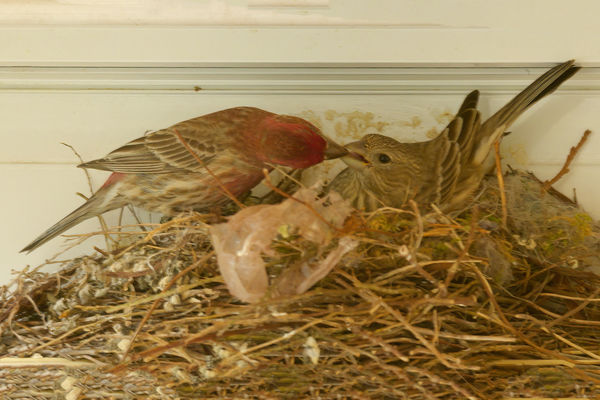
(Download)
The hatchlings ar blind at birth and hunker down silently when their parents are away so as to not attract predators. Although blind they're not deaf and scream for food when they hear their parents nearby.
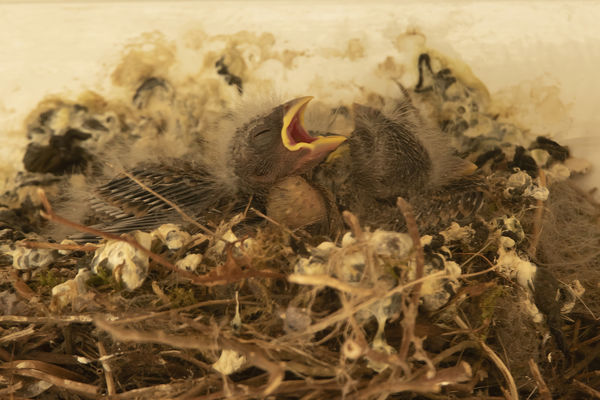
(Download)
The house finch diet is mostly seeds, buds and berries, which both the parents regurgitate into the mouths of the infants. Female house finch feeding infants.
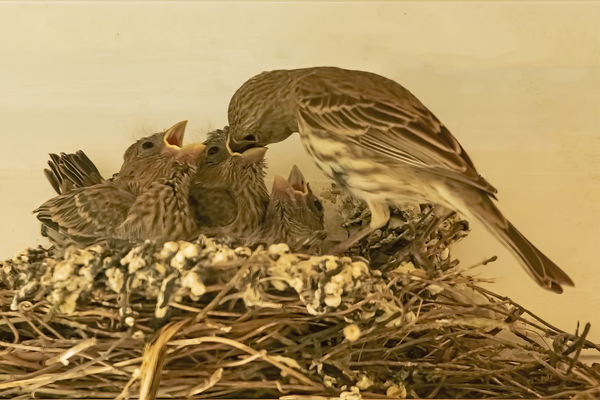
Male house finch feeding the infants.
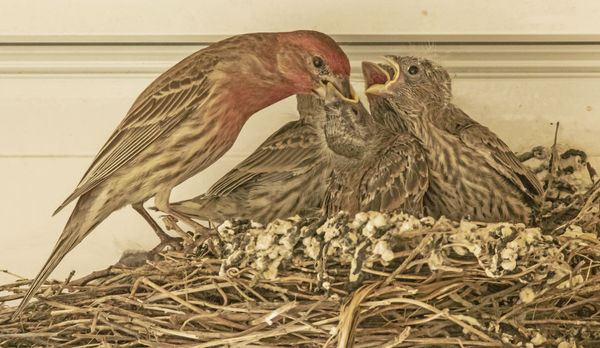
(Download)
The largest of the infants is ready to fly, and was gone along with its siblings the next day.
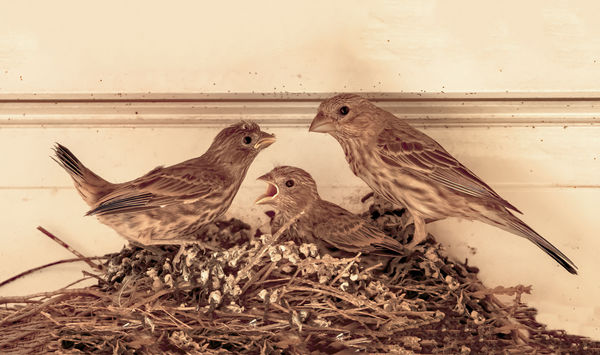
(Download)
Mon (R) and Dad (L) House Finches (Haemoehous mexicanus)
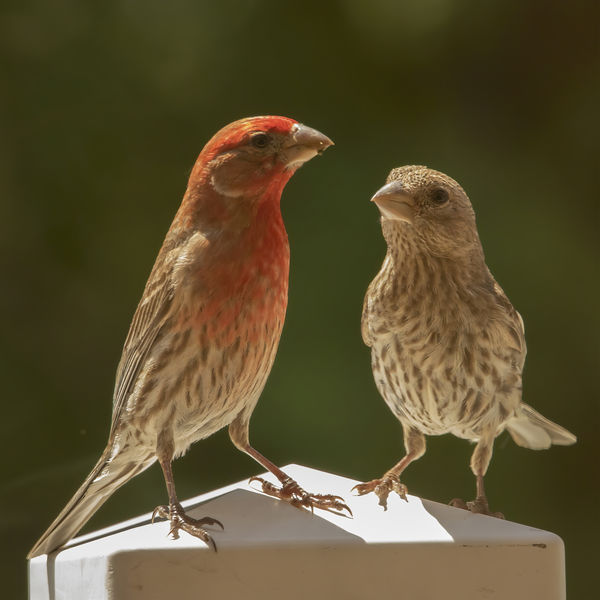
(Download)
The Setup: a Sigma 150-600mm DG lens, canon EOS Rebel T6s and an Alta Pro 263AT tripod.
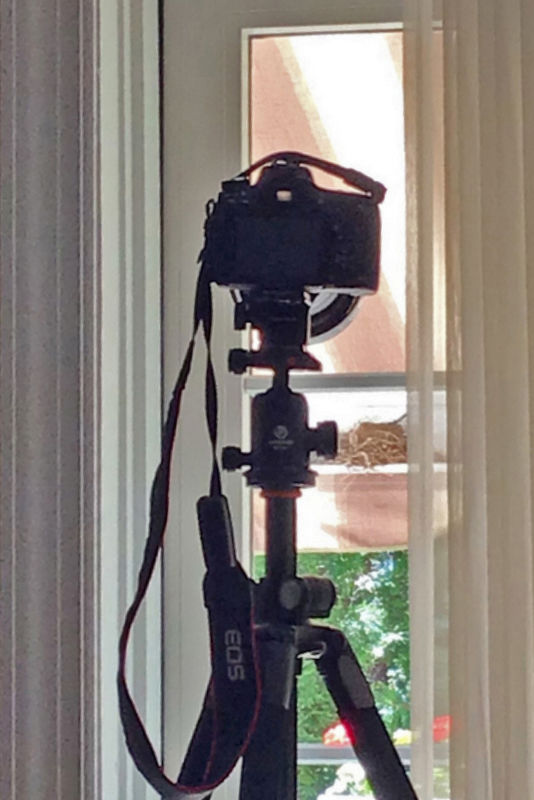
(Download)
The soon-to-be mother builds a nest alone, over a one or two day period, and then selects a mate. The male finch (L) inspects the neighborhood and the nest - newly built by the female (R).
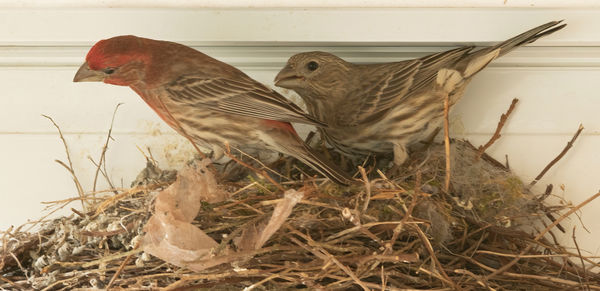
(Download)
For a few days dad protects mom while she incubates the eggs.
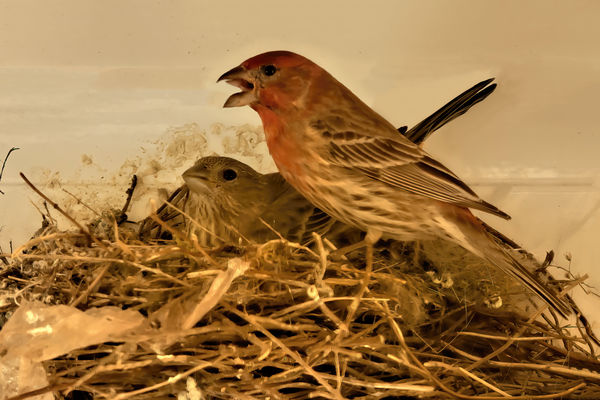
(Download)
Jul 2, 2020 16:20:55 #
Jul 2, 2020 16:40:09 #
Retired CPO wrote:
Very interesting and nice photos. Thanks.
Glad you liked them.
Jul 2, 2020 17:52:56 #
If you want to reply, then register here. Registration is free and your account is created instantly, so you can post right away.


